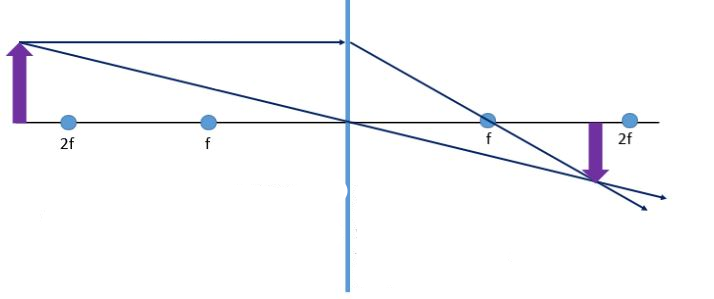
All Solutions
Page 596: Self-Quiz
When they relax, eye lens becomes rounder which decreases focal length and when there is a contraction, eye lens is being elongated which increases focal length.
$$
theta_2=45text{textdegree}
$$
$$
n=1.bar3
$$
$$
n=dfrac{sin theta_1}{sin theta_2}
$$
Solve for $theta_1$:
$$
sin theta_1=ntimessin theta_2
$$
Substitute values:
$$
sin theta_1=1.bar3timessin 45text{textdegree}
$$
Simplify:
$$
sin theta_1=0.943
$$
Solve for $theta_1$:
$$
theta_1=sin^{-1}(0.943)=70.53text{textdegree}
$$
Ray diagram. First the focal length of the lens is measure to determine and mark 2F on this ray diagram and then the image is located:

Refraction causes the phenomenon of apparent depth in which objects, sharks in this case, appear to be placed shallower in the water than they are truly are, when observed from above the water surface.
$textit{b.}$, Shot has to be targeted slightly deeper than where the shark appears to be.
Ratio of the height of virtual image and actual object has to be four.
$textit{b.}$, Student should use the equation of magnification which is given by:
$$
M = dfrac{H_{i}}{H_{o}}
$$
Where:
$M$ – magnification
$H_{i}$ – height of the image
$H_{o}$ – height of the object
$textit{b.}$, Student should use the equation of magnification: $M = dfrac{H_{i}}{H_{o}}$
Data:
$$
f=20
$$
$$
d_o=50
$$
$$
dfrac{1}{d_o}+dfrac{1}{d_i}=dfrac{1}{f}
$$
Rearrange to solve for $d_i$:
$$
dfrac{1}{d_i}=dfrac{1}{f}-dfrac{1}{d_o}
$$
Simplify using least common denominator:
$$
dfrac{1}{d_i}=dfrac{d_o-f}{fd_o}
$$
Rearrange:
$$
d_i=dfrac{fd_o}{d_o-f}
$$
Substitute values:
$$
d_i=dfrac{20(50)}{50-20}=dfrac{1000}{30}
$$
Evaluate:
$$
d_i=dfrac{100}{3}=33.bar3
$$
The image formed is $33.bar3$ centimeters away from the lens on its other side as the object.
$textit{b.}$, In order of increasing energy, radio waves have the least energy, microwaves have higher energy than radio waves and infrared waves have the highest energy , therefore:cellphone, microwave oven, remote controller.
$textit{b.}$, Cellphone, microwave oven, remote controller.
$textit{b.}$, Smudge marks or fingerprints on the surface can ruin its glossy appearance and its ability create specular reflection and will later lead to causing diffused reflection.
$textit{b.}$, Smudge marks or fingerprints on the surface can ruin its glossy appearance and its ability create specular reflection and will later lead to causing diffused reflection.

